Embark on a tantalising journey through time as we unravel the delicious origins of 11 beloved comfort foods. From the humble beginnings of khichdi to the exotic spices that define curry, each dish carries a rich history that transcends mere sustenance.
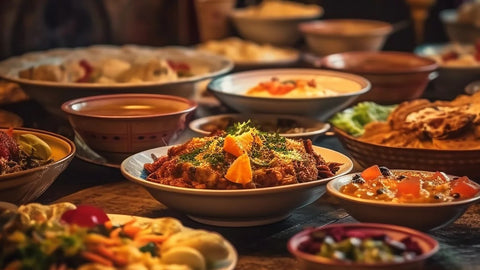
Explore how these culinary delights evolved through centuries, blending cultures and traditions into mouthwatering creations that warm both body and soul. Join us as we delve into the fascinating stories behind these comfort classics, igniting a newfound appreciation for the flavours that bring us comfort and joy. Get ready to savour the past in every bite!
Visit: https://nestasia.in/collections/kitchen
History & Origin Of 11 Best Comfort Food
1. Khichdi
Khichdi, a staple comfort food in Indian cuisine, has roots dating back thousands of years. Initially mentioned in ancient Indian texts, its simplicity and nutritional value made it a favoured dish among peasants and royals alike.
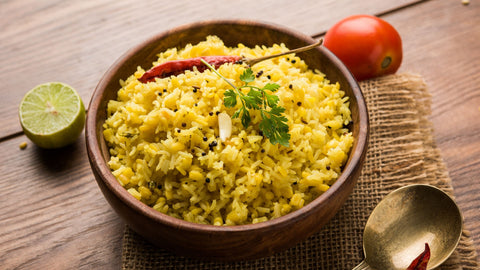
Combining rice, lentils, and an array of Indian spices, khichdi evolved regionally, each variation reflecting local ingredients and preferences. Today, it remains a symbol of comfort and nourishment, cherished for its versatility and ability to soothe both body and mind across generations.
Also visit: https://nestasia.in/collections/cooking-pots
2. Paneer
Paneer, an essential component in countless Indian recipes, holds particular renown in dishes like Palak Paneer, especially cherished in many vegetarian households across the nation. Surprisingly, paneer's origin story suggests it was stumbled upon by accident.
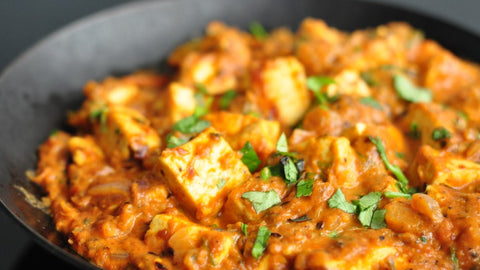
Legend has it that during long Mongol journeys, milk carried in rawhide bags (Mushkis) reacted with desert heat and leather's rennet, resulting in the creation of paneer. This accidental discovery delighted the Mongols' taste buds, leading to its introduction to India by the Mughals. Over time, it merged with Indian spices, becoming a beloved staple. Additionally, ancient texts also hint at paneer-like substances, dating back to Vedic literature.
3. Idli
The earliest mention of Idli dates back to 970 AD in the Kannada text 'Vaddaradhane', where it's served among eighteen items to a visiting Brahmachari. However, this historical narrative lacks the essential elements of modern Idli preparation: the inclusion of rice grits with urad dal, prolonged fermentation, and steaming for fluffiness. Exploring further into antiquity, Chinese chronicler Xuang Zang notes India's absence of steaming vessels.

Some speculate that Indonesian cooks, accompanying Hindu kings between 800-1200 AD, introduced fermentation and steaming techniques, along with their dish 'Kedli', to South India. However, scholars like Lizzie Collingham and Kristen Gremillion remain sceptical since references found at Cairo’s Al-Azhar University Library suggest that Arab traders who settled in South India brought 'rice balls' for dietary reasons. This further muddles the historical narrative, hinting at the complexity of the culinary origins of idli and the cultural influences.
Also visit: https://nestasia.in/collections/cast-iron-cookware
4. Rosogolla
Rosogolla, a quintessential Bengali sweet, traces its origins to the city of Kolkata in the late 19th century. Nabin Chandra Das, a renowned confectioner, is credited with its invention. Seeking to create a unique sweet for his sweet shop, he experimented with cottage cheese (chhana), moulding it into soft, spongy balls and immersing them in sugar syrup. The result was the iconic rosogolla, celebrated for its melt-in-your-mouth texture and delicate sweetness.
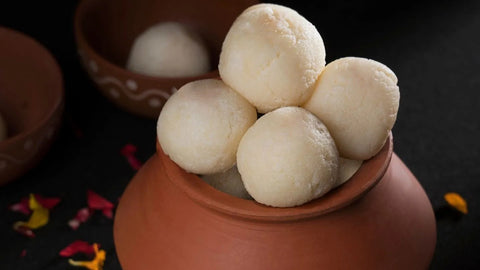
Initially known as "white rosogolla," its popularity soared and became synonymous with Bengali culture. However, the sweet has been a subject of debate, with neighbouring state Odisha also claiming its invention. Despite this, rosogolla remains an integral part of Bengali culinary heritage, enjoyed during festivals, celebrations, and everyday indulgences, symbolising the region's rich culinary tradition and love for sweets.
Also visit: https://nestasia.in/collections/dessert-glasses
5. Jalebi
Jalebi, a cherished delight in Indian cuisine, has roots dating back centuries. Its exact origins are debated, with some attributing it to Persian or Indian origins, possibly introduced by Persian invaders or Jain monks. Early references to jalebi can be traced back to 13th century manuscripts. This intricate treat is crafted from a fermented batter, intricately piped into coils, deep-fried until golden, and then soaked in fragrant sugar syrup.
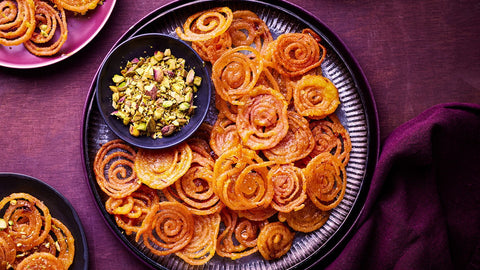
Its popularity quickly spread across the Indian subcontinent and beyond, becoming a staple at festivals, celebrations, and as a comforting indulgence during everyday moments. The journey of Jalebi through time mirrors the rich tapestry of cultural exchanges and culinary innovations that have shaped Indian gastronomy. Its enduring appeal lies in its irresistible combination of crispy texture, sugary sweetness, and nostalgic comfort, making it a timeless favourite.
Also visit: https://nestasia.in/collections/dessert-plates
6. Pav Bhaji
The beloved street food, Pav Bhaji, has a fascinating history rooted in the streets of Mumbai, Maharashtra. Its origins can be traced back to the late 19th century, when it was created as a wholesome meal for textile mill workers. Street vendors concocted a flavourful mash of leftover vegetables cooked with spices and butter, served with soft pav (bread rolls), as a convenient and affordable option for the working class.

Over time, Pav Bhaji evolved into a quintessential Mumbai delicacy, finding its way into homes, restaurants, and street corners across India and beyond. Its popularity transcends social barriers, appealing to people of all backgrounds. Today, Pav Bhaji stands as a testament to the ingenuity of Indian street food culture, offering a comforting and satisfying culinary experience cherished by millions.
Also visit: https://nestasia.in/collections/snack-plate
7. Tandoori Chicken
With its history rooted in the culinary traditions of North India, tandoori chicken boasts a captivating origin story that spans centuries. Originating in the region of Punjab, its creation is credited to Kundan Lal Gujral, a visionary chef who repurposed traditional tandoor ovens to cook marinated chicken at high temperatures. This method imparted a smoky flavour to the chicken while ensuring the meat stayed juicy and tender.
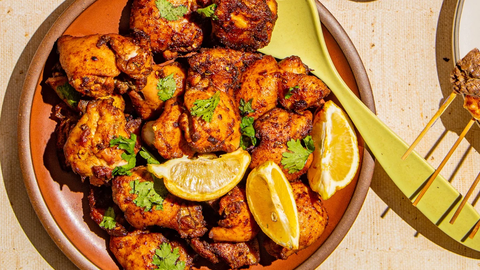
Introduced in the 1940s at Gujral's Moti Mahal restaurant in Delhi, tandoori chicken quickly gained popularity among locals and foreigners alike. Its vibrant red hue, courtesy of spices like Kashmiri red chilli powder, became symbolic of the dish. Today, tandoori chicken is a global favourite, served in Indian restaurants worldwide and even inspiring variations like tandoori paneer and tandoori fish. Its legacy as a comforting, flavourful dish continues to endure, showcasing the culinary prowess and cultural richness of Indian cuisine.
8. Butter Chicken
As a beloved dish in Indian cuisine, butter chicken has a fascinating history dating back to the 1950s in Delhi. It is said to have originated from the inventive mind of Kundan Lal Gujral, a chef who repurposed leftover tandoori chicken by simmering it in a creamy tomato sauce with butter and spices.
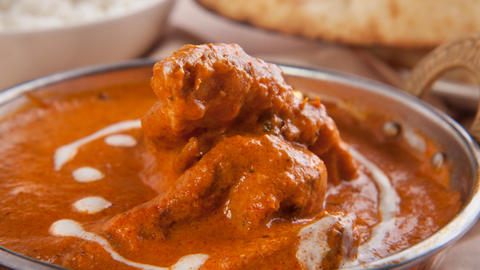
This culinary innovation led to the birth of butter chicken, known for its rich, creamy texture and mild yet flavourful taste. Over the years, it has become a symbol of comfort and indulgence, delighting palates worldwide and earning its place among the favourite comfort foods.
Also visit: https://nestasia.in/collections/serving-bowls
9. Chhole Bhature
Chhole Bhature, the go-to comfort food in North Indian cuisine, has a history steeped in culinary tradition. Originating from the Punjab region, this hearty dish consists of spicy chickpea curry (chhole) served with deep-fried bread (bhature). Its roots can be traced back to the Mughal era when it was enjoyed by royalty and commoners alike. Over the years, it evolved from a simple street food to a cherished delicacy, with each region adding its own twist to the recipe.

Today, Chhole Bhature has gained popularity across India and beyond, becoming a staple in restaurants and households. Its flavourful combination of tender chickpeas, aromatic spices, and fluffy bread offers a comforting and satisfying meal for any occasion. This dish stands as a testament to the rich diversity and culinary heritage of Indian cuisine, capturing the hearts and taste buds of food enthusiasts worldwide.
10. Samosa
Samosa is an all-time favourite Indian snack that boasts a history as rich as its flavour. Originating in the Middle East, it made its way to the Indian subcontinent during the Delhi Sultanate era in the 13th century. Originally named "Sambosa," it underwent a transformation in India, evolving into the iconic triangular pastry filled with spiced potatoes, peas, or meat. Its popularity soared under Mughal rule, becoming a staple street food and later a cherished part of Indian culinary culture.
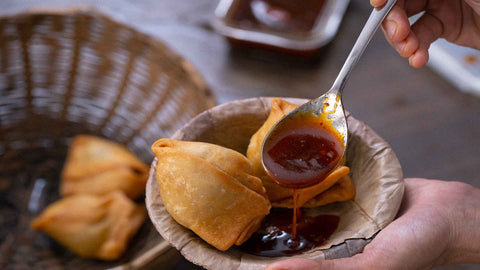
The versatility and portability of samosa made it a favourite among travellers and traders, spreading its influence across South Asia and beyond. To this day, it remains a symbol of comfort and indulgence, enjoyed during festivals, celebrations, and everyday snacking. Its crispy exterior, flavourful filling, and aromatic spices continue to captivate taste buds worldwide, highlighting the enduring legacy of this beloved treat.
Also visit: https://nestasia.in/collections/section-plates
11. Biryani
With roots in the opulent kitchens of the Mughal Empire, Biryani has a captivating history spanning centuries. Originating as a luxurious dish prepared for royalty and nobles, its name is derived from the Persian word "birian," indicating frying before cooking. This culinary masterpiece evolved, blending fragrant basmati rice with tender meat or vegetables, layered with an array of aromatic spices and herbs.
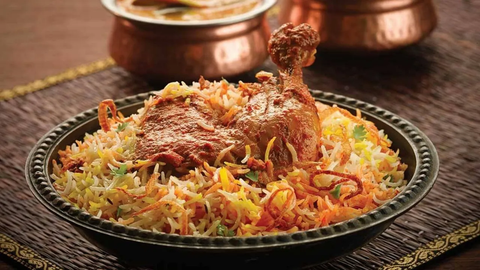
Biryani's popularity transcended borders, spreading across the Indian subcontinent through trade routes and cultural exchanges. Adaptations to regional tastes led to numerous variations, each with its unique charm. Today, biryani stands as a symbol of cultural diversity and culinary artistry, cherished in homes, restaurants, and festivities worldwide. Its exquisite flavours and comforting allure continue to captivate generations, reflecting the rich tapestry of Indian gastronomy and its enduring legacy.
Also visit: https://nestasia.in/collections/dinner-plate
Conclusion
In exploring the origins and evolution of these beloved comfort foods, we've uncovered the threads of history, culture, and innovation woven into each dish. From the humble beginnings of paneer to the royal indulgence of biryani, these culinary delights not only nourish the body but also feed the soul, embodying the rich tapestry of gastronomic heritage cherished across generations.
Also visit: https://nestasia.in/collections/dining





















